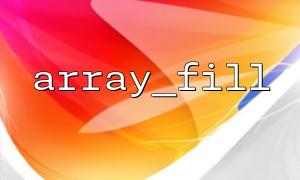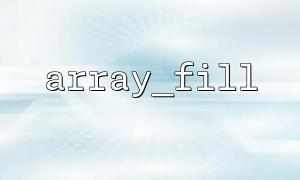In PHP, the array_fill() function is used to create an array with a specified number of elements, and all elements are initialized to the same value. This function is very useful, especially if we need to render placeholder data for certain view layers. With array_fill() we can create an array containing multiple blanks or default values for subsequent display in the view.
In this article, we will explore how to use the array_fill() function to generate blank placeholders and use them for view layer display.
First, let’s understand the basic usage of the array_fill() function. The syntax of this function is as follows:
array_fill(int $start_index, int $num, mixed $value): array
$start_index : The starting index of the array.
$num : The number of elements to be filled.
$value : The value of each array element.
This function will return a filled array.
In many cases, we want to display blank placeholders in the view layer, indicating that the data has not been loaded or is to be filled. We can use array_fill() to generate an array containing an empty string (or other default value).
<?php
// use array_fill() The function generates a containing 10 an array of blank placeholders
$placeholders = array_fill(0, 10, '');
// Output placeholder array
print_r($placeholders);
?>
In this example, array_fill(0, 10, '') creates an array starting with index 0 and length 10, with each element's value being an empty string. The generated array is similar to:
Array
(
[0] =>
[1] =>
[2] =>
[3] =>
[4] =>
[5] =>
[6] =>
[7] =>
[8] =>
[9] =>
)
In actual development, using placeholder arrays can help us render placeholder data on the front-end interface until the back-end data is ready. In the template engine or view layer, we can display the placeholder in this way.
Suppose we want to render 10 placeholders in the template as a preset framework for user information. The above $placeholders array can be passed to the template engine and the corresponding placeholder content can be output in the front-end page.
<?php
// Simulate user data obtained from the database
$users = array_fill(0, 10, null); // Assume we have no user data for the time being
// Passing data to view layer
include 'view.php'; // Assumptions view.php Files are used to render data
?>
In the view.php file, placeholders can be rendered in a similar way:
<?php foreach ($users as $user): ?>
<div class="user-box">
<?php if ($user === null): ?>
<div class="placeholder">loading...</div>
<?php else: ?>
<div class="user-info">
<!-- User information is displayed here -->
</div>
<?php endif; ?>
</div>
<?php endforeach; ?>
In addition to empty strings, the array_fill() function can generate other types of placeholders. For example, we can use numbers, null , or other default values to fill an array.
<?php
// use null As a placeholder
$placeholders = array_fill(0, 5, null);
print_r($placeholders);
// use数字 0 As a placeholder
$placeholders = array_fill(0, 5, 0);
print_r($placeholders);
?>
This will produce the following results:
Array
(
[0] =>
[1] =>
[2] =>
[3] =>
[4] =>
)
Array
(
[0] => 0
[1] => 0
[2] => 0
[3] => 0
[4] => 0
)
The array_fill() function is a very simple and powerful tool, especially when it is necessary to generate placeholder data. By filling the array with empty strings, null , or other default values as placeholders, we can easily render content in the view layer until the backend data is ready. This approach improves the user experience and ensures smooth transitions to page content when dynamically loading data.














